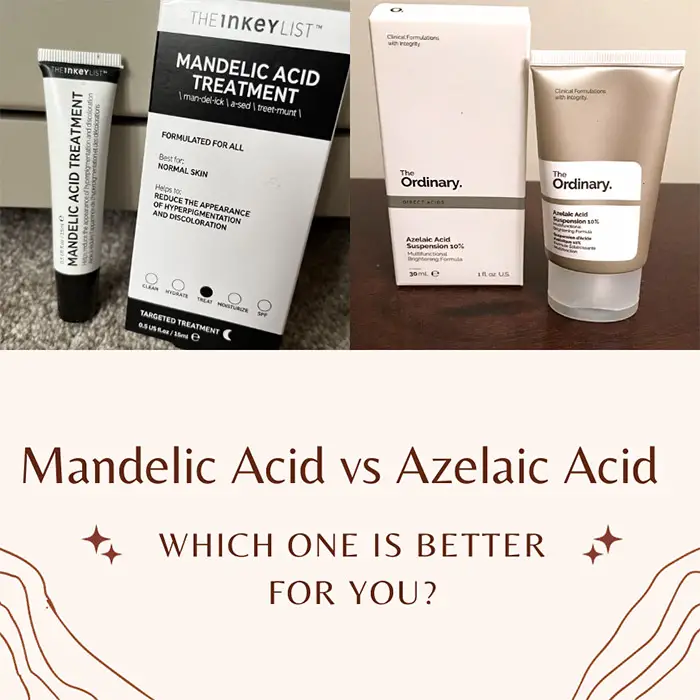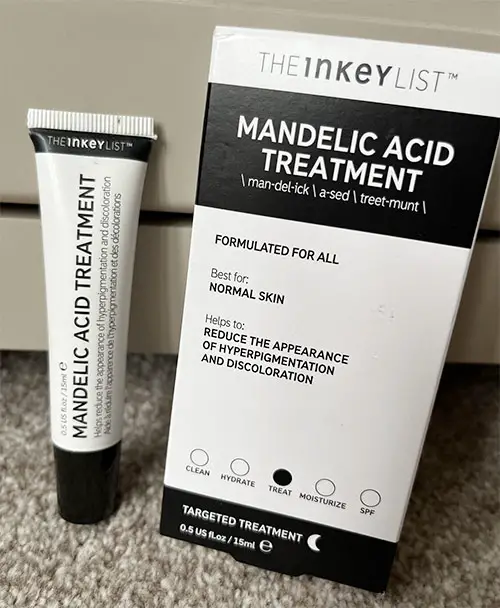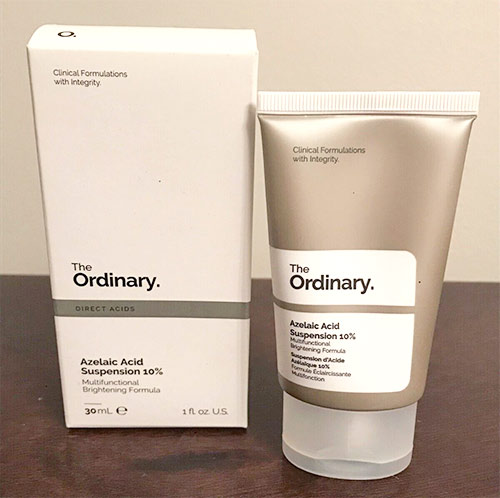
If you are someone who has been looking for a solution for acne, hyperpigmentation, or anti-aging, chances are you have come across mandelic acid and azelaic acid. Both of these acids have been gaining popularity in the skincare industry for their unique benefits.
However, if you are wondering which one to choose, this article will provide you with a detailed comparison of mandelic acid vs azelaic acid.
Table of Contents
- What is mandelic acid?
- Benefits of Mandelic acid for skincare
- What is azelaic acid?
- Benefits of Azelaic acid for skincare
- Difference between mandelic acid and azelaic acid
- How to choose between azelaic acid and mandelic acid
- Can mandelic acid and azelaic acid be used together?
What is mandelic acid?
Mandelic acid is a type of alpha-hydroxy acid (AHA) derived from bitter almonds. Known for its gentle nature, this chemical exfoliant works by breaking down the bonds between dead skin cells on the skin’s surface. Its ability to gently exfoliate makes it suitable for sensitive skin types and those new to chemical exfoliants.

Benefits of Mandelic acid for skincare
Mandelic acid has numerous benefits for the skin, including:
Exfoliating benefits
It helps to remove dead skin cells, making the skin smoother and brighter. It works by breaking down the bonds between dead skin cells, allowing them to be easily removed from the surface of the skin.
Acne treatment
Mandelic acid chemical peels are regularly used in the treatment of acne and hyperpigmentation, especially for sensitive skin types. It helps to fight acne-causing bacteria, due to its anti-bacterial properties.
In this study, a 30% mandelic acid peel was found to be effective in treating inflammatory forms of acne with less irritation to the skin as opposed to a glycolic acid peel.
Anti-aging
Mandelic acid is proven to help to stimulate collagen production. This helps reduce the appearance of fine lines and wrinkles resulting in firmer and younger-looking skin.
Improves Hyperpigmentation
Mandelic acid gets absorbed slowly and uniformly on the surface layer of the skin and gently lifts dead skin, lightens dark spots and improves hyperpigmentation, resulting in a more even skin tone.
What is azelaic acid?
Azelaic acid is a dicarboxylic acid that naturally occurs in grains such as wheat and barley. It’s recognized for its gentle skin care properties. Unlike many harsh chemicals, azelaic acid works subtly, making it a suitable ingredient for various skincare formulations. It’s particularly known for its mild exfoliating action, which helps in managing skin texture and clarity.

Benefits of Azelaic acid for skincare
Azelaic acid also has numerous benefits for the skin, including:
Acne Treatment
Due to its mild exfoliating properties, azelaic acid is commonly used in the treatment of comedonal and inflammatory acne. It helps to unclog pores by reducing the production of keratin in the skin, a protein that congests pores and triggers breakouts.
Reduces Inflammation
Azelaic acid has strong anti-inflammatory properties that make it ideal for the treatment of inflammatory skin conditions like rosacea and acne. In a 2006 study, azelaic acid was found more effective than metronidazole a standard rosacea treatment.
Can help fade hyperpigmentation
Studies show that azelaic acid has the ability to kill melanocytes (cells that produce melanin) reasons why its effective in lightening dark spots and reversing hyperpigmentation for a more even skin tone.
The anti-oxidant benefits
This acid has a significant antioxidant activity which gives it the ability to protect the skin from exposure to the sun.
Improves skin texture
Azelaic acid has mild exfoliant due to its keratolytic properties. Azelaic acid helps break down keratin and loosens dead skin cells on the top layer of the skin for a smoother skin texture.
Difference between mandelic acid and azelaic acid
Mandelic acid, with its larger molecular size, penetrates the skin more slowly and evenly, making it gentler and less irritating. It excels in lightening dark spots, improving hyperpigmentation, and promoting even skin tone. Additionally, its exfoliating and collagen-stimulating properties contribute to anti-aging benefits.
Azelaic acid, while also offering anti-aging benefits through collagen stimulation, is particularly effective for acne treatment due to its potent anti-inflammatory effects. Both acids aid in reducing fine lines and wrinkles, but mandelic acid is often preferred for sensitive skin due to its gentler nature.
Pros of Mandelic Acid:
- It has a larger molecular size than other AHAs, which means it is less irritating and better tolerated by sensitive skin.
- It has antibacterial properties, making it effective for treating acne-prone skin.
- It is effective at improving skin texture, reducing the appearance of fine lines and wrinkles, and evening out skin tone.
- It is less likely to cause post-inflammatory hyperpigmentation (PIH) than other AHAs, making it a good choice for darker skin tones.
Cons of Mandelic Acid:
- It may take longer to see results compared to other AHAs because it penetrates the skin more slowly.
- It may not be as effective at treating severe acne or hyperpigmentation as other acids.
Pros of Azelaic Acid:
- It has anti-inflammatory properties, making it effective for treating acne and rosacea.
- It is effective at reducing hyperpigmentation and evening out skin tone.
- It has antioxidant properties, which can help to protect the skin from environmental damage.
Cons of Azelaic Acid:
- It may cause initial irritation or dryness when first starting to use it.
- It may not be as effective at exfoliating dead skin cells as other acids.
- It may take longer to see results compared to tyrosinase inhibitors like retinoids.
How to choose between azelaic acid and mandelic acid
Both mandelic acid and azelaic acid have unique benefits and drawbacks, and when deciding which is better for your skin it’s important to consider your skin type and concerns.
For acne:
If you have acne-prone skin azelaic acid may be the best option for you. It will help unclog your pores and get rid of acne-causing bacteria, calm inflammation and redness as well as help reduce acne scarring.
For hyperpigmentation:
If you have sensitive skin, mandelic acid may be better for clearing discolorations on your skin by gently exfoliating dead skin cells. On the other hand, azelaic acid may be more effective for other skin types and produce results faster. However, it may be more irritating for sensitive skin types.
It’s also important to note that both acids can increase sun sensitivity, so be sure to wear sunscreen daily when using them.
Ultimately, the best way to choose between azelaic acid and mandelic acid is to try both and see which one works best for your skin. You may find that one acid is more effective than the other or that your skin reacts better to one over the other.
Can mandelic acid and azelaic acid be used together?
Yes, you can use mandelic acid and azelaic acid together, especially for treating acne-prone skin or hyperpigmentation. However, It’s important to start slowly and watch how your skin reacts. Try using them on different days or one in the morning and the other at night. Always keep your skin moisturized and use sunscreen for protection.
How to use mandelic and azelaic acid together safely
Here are some tips on how to use mandelic and azelaic acid together safely:
- Patch test first
Before using any new product or combination of products on your face, it’s important to patch test them on a small area of skin first. Apply a small amount of the mandelic and azelaic acid mixture to the inside of your wrist or behind your ear and wait 24 hours to see if there is any reaction.
- Start slow
If the patch test is successful, start using the mandelic and azelaic acid mixture slowly, once a week at first, and gradually increasing the frequency over time if your skin tolerates it.
- Use a lower concentration
When combining mandelic and azelaic acid, it’s best to use a lower concentration of each. This will minimize the risk of irritation while still providing the benefits of both acids.
- Apply in the correct order
When layering skincare products, it’s important to apply them in the correct order to maximize their benefits. Apply mandelic acid first, wait a few minutes for it to absorb, and then apply azelaic acid.
- Consider using a buffer
If you have sensitive skin, you may want to consider using a buffer, such as a moisturizer, between the mandelic and azelaic acid layers. This can help to minimize the risk of irritation while still allowing both acids to work effectively.
- Use sunscreen
Both mandelic and azelaic acids can make your skin more sensitive to the sun, so it’s important to use a broad-spectrum sunscreen with an SPF of 30 or higher when using these acids together.
Related articles:
The Complete Guide to Using Mandelic Acid
How to Use Mandelic and Hyaluronic Acid in Your Routine
Mandelic acid vs Glycolic acid
Can I use mandelic acid and alpha-arbutin together?
Mandelic Acid and Vitamin C Comparison

Petra Nakashian (previously Kravos) is a dedicated natural health and beauty blogger, driven by the loss of her parents to cancer, which led her to meticulously research beauty product ingredients. With over 10 years of experience, her in-depth knowledge has made her a trusted expert in the field. Founder of Be Healthy Now and Green Beauty Talk, Petra recently expanded her expertise with Beauty Insights Hub, exploring a wider range of beauty treatments. Committed to transparency and honesty, her work is a vital resource for navigating the complex world of beauty.

